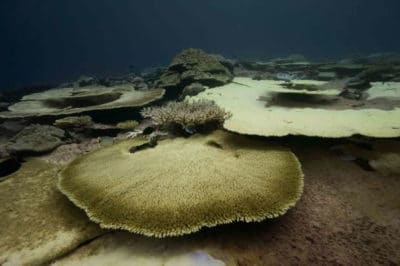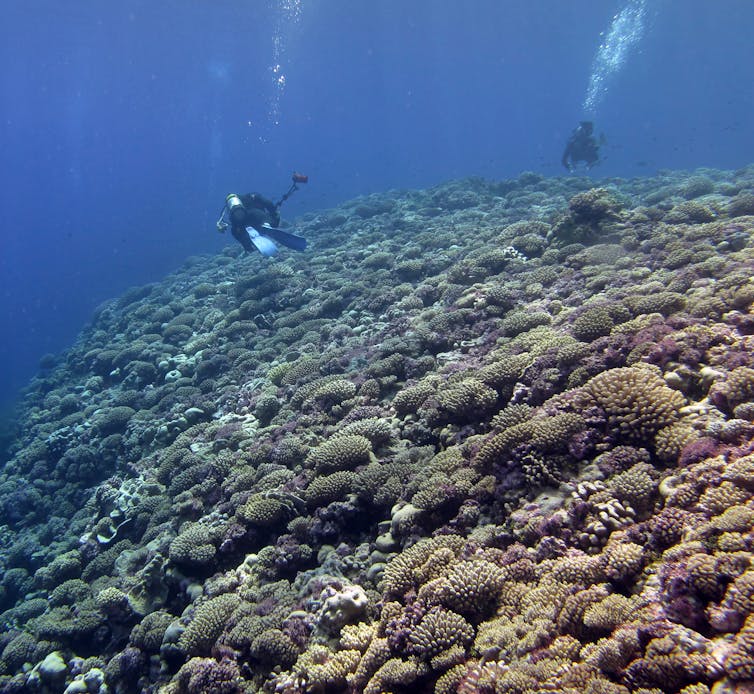Are reef corals stressed or just pessimistic?
(2018)
The Conversation
December 14, 2018
By Anderson Mayfield

Climate change threatens coral reefs around the globe. The high temperatures associated with this phenomenon can lead to “bleaching,” the breakdown of the symbiosis between corals and the algae that live within their cells. Since corals are nourished by these photosynthetically active algal “symbionts,” bleaching – so called because the coral tissues become clear/white, exposing the white skeleton beneath – typically results in coral death.
At least half-a-billion people on Earth rely directly on coral reefs for their livelihood. Coral reefs provide a wealth of ecosystem services not only to the plethora of marine creatures that live on coral reefs but also to humans. For example, reefs are nurseries for myriad commercially important fish species.
That’s why we need to actively monitor the health of coral reefs around the globe. I am particularly interested in identifying reefs that are stress-sensitive or of limited resilience. Perhaps such reefs should be prioritised for conservation under the unfortunate assumption that saving all reefs may no longer be feasible. Then again, maybe we should instead focus our efforts on reefs featuring the strongest corals, as these will stand a better chance of survival.
Regardless, we need a way to determine whether a reef is healthy or sick.
Reactionary diagnosis
Historically, coral reef health assessment has been a retroactive endeavour. We strap on our SCUBA tanks, go diving and record the number of corals that are dying or dead. This would be akin to telling someone who just had a heart attack that they had high blood pressure. Ideally, that person would have liked to have known earlier so they could have made dietary or other lifestyle changes to prevent cardiac arrest.
If we only diagnose coral death, the data acquired during our surveys are of little use to living corals. Wouldn’t it be better if we could detect declines in coral health before severe, late-stage signs of sickness such as bleaching are evident? Then, we could alert managers so they could act to promote coral resilience at local scales by, for instance, closing the reef to fishing.
We don’t know what truly healthy coral looks like
Unfortunately, we don’t have a physiological baseline for corals. All coral reef research has been undertaken in the last 50 to 100 years. That’s well after the start of the Industrial Revolution, the point at which our collective human impact on the planet really jumped into high gear.
In other words, all data we currently possess are from corals that are already likely to be stressed to at least some degree. Even the most geographically isolated reefs, those of Chagos in the Indian Ocean, are bleaching almost yearly.
Although this means that no pristine reefs remain on Earth, it is still possible that healthy ones are out there to be found. But knowing what actually constitutes a healthy reef is tricky given the lack of baseline data. If we don’t know how to define the phenotype of a healthy coral, how can we be expected to document the degree of stress or the likelihood of bleaching?
Studying coral health through molecular biology
Over the last 15 years, I’ve developed a series of molecular diagnostic procedures geared towards making conjectures about coral health. For those who studied cell biology, you may recall that all cellular organisms possess a suite of proteins that protect, stabilise and/or repair their cells during stress events, such as high temperature exposure. Although some “stress proteins” may be synthesised at all times (even when cells are unstressed), the majority should be produced by the cells only when they are actually stressed.
By that logic, even if we lack baseline data, we should be able to develop a diagnostic system for corals based on concentrations of stress-indicative genes and proteins I will collectively refer to as “molecular biomarkers.” Corals, after all, consist of cells with very similar genomes to ours (at least in the case of the hosts).
My idea, then, was to go to the world’s most “pristine” (tongue firmly implanted in cheek) ecosystems, sample corals, and analyse the concentrations of a number of gene and protein-level molecular biomarkers involved in the cellular stress response. This would serve to generate “current baseline” data for reef corals against which we could compare future shifts as a result of climate change and other human activities.
From 2013 to 2016 I sampled corals from the most remote reaches of the Indo-Pacific as a postdoctoral researcher with the Khaled bin Sultan Living Oceans Foundation (LOF). As part of LOF’s “Global Reef Expedition” (GRE), small crumbs of tissue (i.e., “biopsies”) were removed from each of thousands of coral colonies (focusing on the genus Pocillopora), ranging from French Polynesia’s Austral Islands to the Chagos Archipelago (British Indian Ocean Territory), and hundreds of sites in between. We focused on reefs that had not previously been surveyed or explored, which tended to be the ones farthest from human populations.
Are corals in a constant state of stress?
After carrying out a variety of molecular diagnostic procedures, I found that every coral I sampled appeared to be characterised by incredibly high concentrations of all stress biomarkers targeted (in both the coral host and endosymbiotic algal “compartments”).
This was the case in remote atolls of the Austral and Cook Islands, as well as Fiji, Tonga, New Caledonia, the Solomon Islands, Palau and Chagos.

The simplest explanation for the observation that every coral I sampled was displaying the cellular hallmarks of a stress response is that the corals were indeed stressed. However, some have argued that corals are different and, unlike other cell organisms, can stay “stressed” at all times to anticipate environmental change.
This is true in some ecosystems, such as upwelling coral reefs of Southern Taiwan, where seawater quality changes rapidly on a regular basis. That being said, we found few reefs encountering such extreme environments on our pan-global research expedition.
Stressed or just ‘pessimistic’?
Most stressed cells or organisms stop growing and reproducing since so much energy is being diverted to restoring cellular equilibrium, also known as homeostasis. This was not the case for these “stressed” corals, nor did the majority show any signs of tissue necrosis or disease. Furthermore, although some went on to bleach at later dates, not all did.
In other words, the fact that the coral and internal algal cells were constantly utilising their stress responses did not necessarily mean that the coral “holobionts” (an amalgamation of host+symbiont) would eventually disintegrate.
Perhaps the mobilisation of reserve energy stores, such as fats, has allowed these corals to persist to date, despite being stressed. This would be a short-term survival strategy at best, though. Maybe they switched from relying on photosynthesis to simply eating more plankton, as do many other marine animals lacking in algal symbionts.
Or maybe, as mentioned above, corals are just weird; rather than the ephemeral “fight or flight” response employed by other animals, they remain “physiologically pessimistic”, prepared for the worst at all times. Only return trips to these sites will tell whether this perceivable stressful lifestyle permits continual coral survival in the coming decades.
